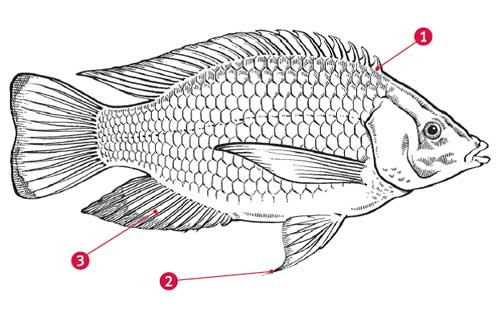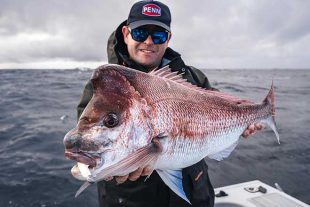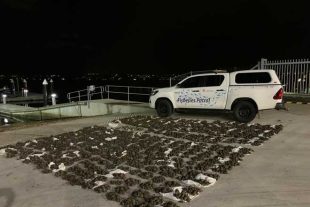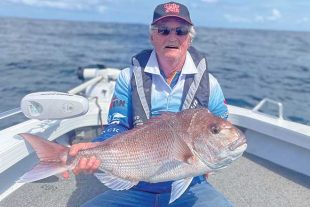Tilapia is in the top 100 of the world’s worst introduced species. It is a real risk to NSW’s native fauna and our environment.
If you see a fish you think might be tilapia, call the NSW DPI Aquatic Biosecurity 24-hour hotline 1800 675 888.
Why are Tilapia a risk to native fish and habitats?
Characteristics allow tilapia to establish in new areas include:
- Highly efficient breeding strategies including mouth brooding
- Simple food requirements (feeding on a wide variety of plant and animal matter)
- Flexible habitat preferences (including the ability to breed in both fresh and brackish water).
Impacts tilapia have on native fish and habitats include:
- Competition with native species for food and space
- Predation upon the eggs and young of native species
- Aggressive behaviour of tilapia can lead to poor condition and higher infection and mortality rates for native species
- Nest building by male tilapia may also damage aquatic habitats through damage to aquatic vegetation and increased turbidity.
Where did tilapia come from?
Tilapia are native to warm, fresh and brackish waters of Africa, South and Central America, southern India and Sri Lanka. Tilapia were historically imported to be kept as aquarium fish. Due to the significant risk these fish pose to native fish and the environment they are now listed as a notifiable pest under NSW legislation meaning it is illegal to possess, sell or move tilapia.
What is NSW DPI doing to help?
NSW DPI works with other government agencies, non-government agencies, industry and the community to minimise the risks of tilapia spreading and establishing throughout NSW. This approach recognises that biosecurity is a shared responsibility.
NSW DPI:
- Maintains legislation regarding notifiable species such as tilapia
- Monitors fish populations in coastal and inland rivers in NSW
- Prepares for potential incursions of pest species
- Responds to reported sightings of pest species, including tilapia
- Works to raise awareness of pest species, including through collaboration with local government and environmental organisations (e.g. advisory materials, workshops, media releases).
- In 2023, NSW DPI released the tilapia control plan. It sets goals, priorities and actions to improve NSW’s overall ability to prevent and respond to new tilapia incursions and manage the negative impacts of established populations.
General Biosecurity Duty
Under Biosecurity legislation, all community members in NSW have a general biosecurity duty to consider how actions, or in some cases lack of action, could have a negative impact on another person, business enterprise, animal or the environment. We must then take all reasonable and practical measures to prevent or minimise the potential impacts of pests and diseases.
How you can help stop the spread of tilapia
Tilapia infestations are usually caused by people moving the fish between waterways. Help stop this spread with the following guidelines:
- Don’t release fish into waters or allow fish to escape into waterways. It is illegal to return any recreationally caught tilapia to the water. If caught whilst recreational angling they must be humanely dispatched and utilised or disposed of in a bin going to landfill
- Don’t use suspected pest species as bait (whether dead or alive). Even dead tilapia may still have eggs or young in their mouths
- Obtain a permit from NSW DPI prior to any fish stocking activities and stock fish from a reputable local supplier rather than another region or interstate (to minimise risks of introducing species not native to your local area). Note – it is illegal to release fish into waters without a permit and heavy penalties apply
- Give unwanted aquarium fish to a friend or a pet shop. If a suitable home cannot be found, please see the recommended guidelines for humane destruction of fish
- Learn how to identify tilapia
- Be on the lookout for new species of fish in your area
- Report sightings of suspected tilapia, take good quality photographs and freeze the whole fish where possible
- Clean your gear (e.g. landing nets, boots) and check for signs of eggs or young tilapia. If found, ensure these eggs and young are not able to re-enter any NSW waters.
How to identify tilapia
- Tilapia vary in colour from dark olive to silver-grey, depending on their age and environment
- They are generally deep-bodied fish with thin profiles, long snouts and pronounced lips/jaws
- Their dorsal (upper) fin (1) is continuous and ends in an extended point. Most native species have a dorsal fin with a dent/gap in the middle and a rounded end
- Their pelvic (belly) fins (2) are long and almost touch the front of the anal (bottom) fin (3). This is unlike most native species, which have short pelvic fins.

 Bush ‘n Beach Fishing Magazine Location reports & tips for fishing, boating, camping, kayaking, 4WDing in Queensland and Northern NSW
Bush ‘n Beach Fishing Magazine Location reports & tips for fishing, boating, camping, kayaking, 4WDing in Queensland and Northern NSW









